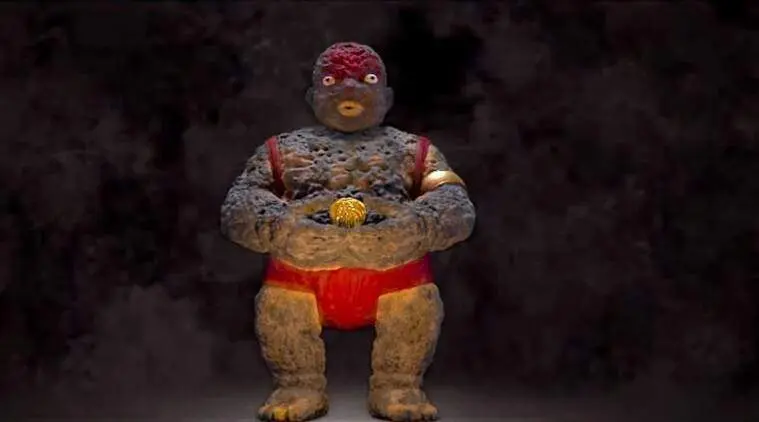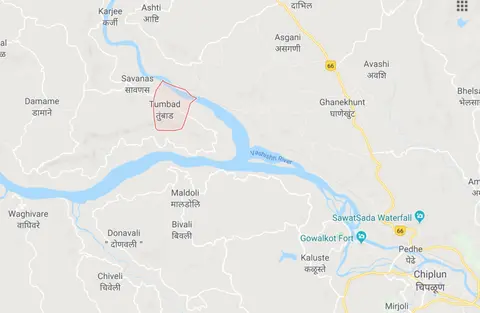
Hastar is a cursed Hindu god who lives inside the womb of the Goddess of Plenty per some legendary stories. He came into the limelight because of the movie Tumbbad in which he is the central character. Because he is not mentioned in any Hindu scriptures, many people think he is a fictional god, but many Hindu gods are not mentioned in any book and are still worshiped by Hindus.
Legend of Hastar (per Tumbbad movie):
Hastar is the first and most loved son of Goddess of Plenty (Purti ki Devi). The Earth is her womb. When the universe began, the goddess gave birth to 16 crore gods and goddesses, but the goddess loved his first child, Hastar, the most. But Hastar is very greedy. He wanted all the wealth to himself only. So he stole all the gold of the goddess, but before he could steal the grains, his siblings (other gods and goddesses) attacked him and shattered him into pieces. But the love of the goddess kicked in, and she stopped him from being disintegrated into the universe. But the life came at the cost that no one would ever worship him, and his name would be forgotten forever.
Possible Origin of Hastar:
Although his name is not mentioned in any Hindu scriptures, his story seems to be the product of verses in the Rig Veda and the Mahabharata.
In the Rig Veda, there is a god named Tvastar, who is mentioned as the womb god. He is addressed as a vivifier.
“Even in the womb God Tvaṣṭar, Vivifier, shaping all forms, Creator, made us consorts.” – (RV Book 10, Verse 10.5)
In the Puranas, he is addressed as Lord Vishwakarma, the architect of gods.
In the Mahabharata, he is mentioned as an enemy of Indra who creates Vritrasura after Indra kills his son Trishira.
“Now when the lord of creatures, Twashtri, heard that his son had been slain by Indra, his eyes became red with ire, and he spoke the following words, ‘Since Indra hath killed my son who had committed no offense at all, who was constantly engaged in the practice of austerities, who was merciful, possessed of self-control, and of subdued passions, therefore, for the destruction of Indra, I will create Vritra.” – (MB Udyoga Parva, Section 9).
If we combine these two stories, then what we get is a womb God who is an enemy of gods. Therefore, the legend of Hastar is not entirely fictional but has some base in the scriptures.
Tumbbad Village:

The village mentioned in the movie is real and mysterious. It is a small village in the Ratnagiri district of Maharashtra where some part of the movie was shot. It is about 15 km from Chiplun. The villagers believe that there is a big treasure hidden in their village yet to be discovered. They also believe that some Konkani Brahmins evoked the ghost-like spirit of the Hastar god for their benefit. The village receives heavy rainfall during the monsoon. There is a fort in a dilapidated condition named Gowalkot Fort.
Hastar Temple:
There seems to be no temple of him. When I searched for it on Google, I found one vague result, but there is no picture or information about it.
The Story of Tumbbad Movie:
It is one of the best horror movies in Bollywood. The plot of the movie is an extension of a short story by an eminent Marathi author, Narayan Dharap. This story is in the book Anolkhi Disha – Part 3.
In 1918, in Tumbbad, Maharashtra Vinayak’s mother serves the local lord, Sarkar, in his mansion. It includes offering him sexual services in the hopes to acquire a single gold coin kept with his Hastar statue. Meanwhile, at their home, Vinayak and his younger brother Sadashiv worry about having to feed the monstrous old woman, Vinayak’s great grandmother, chained up in a separate room. Sarkar later dies, and the mother proposes leaving Tumbbad for Pune. Vinayak insists on finding the treasure that is rumored to be hidden somewhere in the mansion. Sadashiv gets badly hurt after falling from a tree, forcing his mother to take him for help. She tells Vinayak he will have to feed his grandmother that night. She also warns him that if the old woman wakes up, he should say the name “Hastar” to make her sleep. Meanwhile, Sadashiv dies on the way to the doctor.
The mother directs her carriage driver to Sarkar’s mansion where she retrieves the gold coin. As Vinayak tries to feed her, the monstrous and hungry old woman attacks and shackles him to eat him, who eventually remembers Hastar’s name and uses it to make her fall asleep. His mother returns, and the next day she and Vinayak leave Tumbbad for Pune. She forces Vinayak to promise never to return to Tumbbad, despite his protests to stay and search for the treasure.
Fourteen years pass and Vinayak grows up. Desperate to escape his life of poverty, Vinayak returns to Tumbbad. The old woman, with now a tree growing out of her body, warns him he will be cursed to become immortal and turned into a monster like her if he touches the treasure. She explains that a well leads to the goddess’ womb where Hastar dwells, in exchange for ending her prolonged suffering. Vinayak keeps his promise and sets her on fire, thus killing her.
Although Hastar stole the goddess’ gold, he was unable to acquire her grain. Therefore, being hungry for years, he desires flour. Vinayak physically trains himself to climb up and down a long rope and makes dolls out of dough to lure Hastar inside the goddess’ womb. While he is distracted by the food, Vinayak swipes at Hastar’s loincloth containing the gold. Vinayak regularly repeats the procedure to steal dropped coins. He offers his first gold coin to the opium merchant Raghav to pay off a debt. Each time he needs more money, Vinayak returns to Tumbbad to steal from Hastar.
Raghav openly wonders about the treasure rumored to exist in the Tumbbad mansion while also questioning why Vinayak can only retrieve a few coins at a time. Vinayak and his wife give birth to their son Pandurang. When Sergeant Cooper gives him only two days to come through with the money, Raghav sells his widowed daughter-in-law to Vinayak as a mistress. Vinayak follows Raghav to the Tumbbad mansion and tricks him into descending into Hastar’s well. Hastar viciously attacks Raghav, turning him into a monster and mutating him into the walls of the womb. Vinayak burns Raghav alive to end his suffering.
In 1947, Vinayak takes Pandurang to the mansion to train him for the same purpose and is told not to bring the dough doll down. But he secretly brings a dough doll, and Hastar unexpectedly attacks. They barely manage to escape, and Vinayak chides his son for nearly getting them touched. Pandurang suggests stealing Hastar’s loincloth, and they make dozens of dough dolls to distract Hastar.
However, the two of them become trapped inside the womb when separate Hastars appear for each one of those dolls. With no hope of escaping, Vinayak ties the dolls to his body to act as bait. Once the coast is clear, Pandurang climbs back to the surface to see his father being mutated into a monster outside the well. Vinayak presents him with the stolen loincloth that he stole from Hastar, but Pandurang refuses to take it. Sobbing at seeing what his father turned into, Pandurang reluctantly sets Vinayak on fire and leaves.
Characters Resembling Hastar in Greek Mythology and Bible:
In Greek mythology, Cronus is the son of Uranus and Gaea. Gaea is the Earth Goddess in Greek mythology. Cronus was defeated by Zeus. Then he became the prisoner of the infernal region.
Another mythological figure who bears resemblance to Hastar is Mammon. His story is found in the New Testament of the Bible. He is the god of material objects, In Hebrew, the word Mammon means money. Mammon is often personified as the demon of wealth and greed.
Is Hastar a real god?
Before coming to any conclusion, let us first summarize what we have read so far.
1. Although there is no reference to Hastar in any Hindu scriptures, it has a close resemblance with Tvastar who is a god from the Rig Veda.
2. The names Hastar and Tvastar sound similar.
3. Tvastar is an enemy of gods per the Mahabharata and also per the legend.
4. Tvastar’s son Trishira was doing penance to win heaven at his encouragement. It shows his greedy nature.
5. There is a real legend about Hastar in Tumbbad village that resembles the plot of the movie.
6. The villagers believe that there is a treasure in their village.
7. There are many Hindu gods worshipped locally who are not mentioned in the Vedas or Puranas.
From all the above points, we can conclude that there is a great possibility of Hastar being a real Hindu god worshiped locally by some Hindus.
Image Source: IMDB